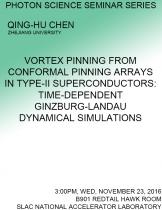Speaker: Qing-Hu Chen, Zhejiang University
Program Description
Recently, conformal pinning arrays, topological perfect two-dimensional structures, easily introduced in the superconducting films, have been demonstrated to produce much high critical currents over a wide range of magnetic fields by both molecular dynamical simulations and experimentally. However, some features inherent to vortex motion have not been properly considered by molecular dynamics simulation. Especially, one to one mapping the vortex to a particle breaks down at higher driven where the vortex displacement are highly anisotropic. More over the driven elongated vortices are eventually transformed into phase slip line.
We employ the time-dependent Ginzburg-Landau (TDGL) equation based on complex superconducting order parameters to simulate the transport properties of the type-II superconductors with different pinning patterns. We introduce the fast Fourier transform to treat the boundary condition transverse to the driven direction to facilitate the simulation and remove the surface barrier for the vortices. In this way, we can study the pinning effects from different pinning arrays in very large systems. We will also use TDGL to study the ratchet effect induced by the artificial conformal pining arrays. Jumps of the IV curves in two opposite currents are clearly observed, and can be explained in terms of phase slip lines and vortex stream picture. Finally, simulations on a TDGL reduced phase model for phase diagram of the vortex matter are also presented.





